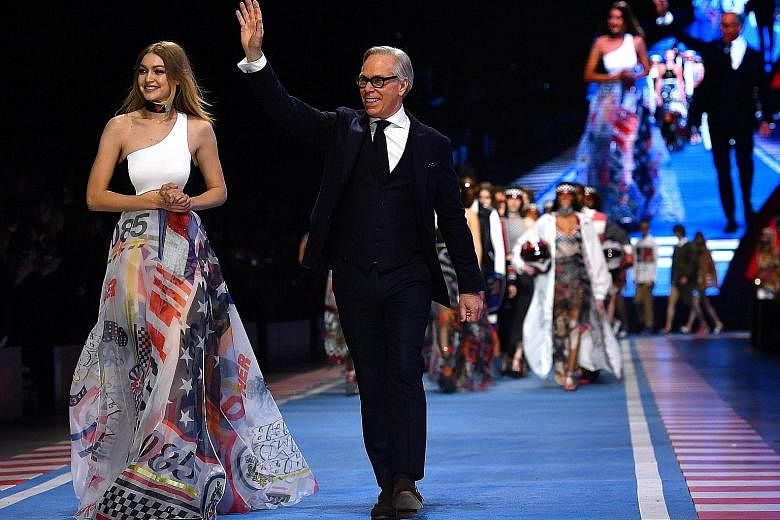NEW YORK • Tommy Hilfiger had the final night of February's Milan Fashion Week all to himself. Inside the city's Congressi fairgrounds, the designer's latest big-budget extravaganza sent models down a racetrack-themed runway in colourblocked leather pants and crop tops.
It was the fourth and final collection co-designed by model-of-the-moment Gigi Hadid, in a lucrative partnership that started in autumn 2016.
Like the previous three collections, all the clothes shown in Milan were instantly available as part of Tommy Now, the company's "see now, buy now" initiative, which erases the standard six-month wait between the runway and retail and allows for something rare: instant gratification.
As soon as the show began, savvy shoppers could order US$130 (S$171) sweatshirts or a US$460 pair of sheer overalls through the label's website, its social media accounts, the event livestream and TommyNow Snap, an image-recognition app.
Elsewhere, artificial-intelligence-powered chatbots used Facebook Messenger to act as virtual stylists for thousands of customers. There was a buzz of interest on every platform, a far cry from the year 2000, when the brand's stock plunged 75 per cent in a single quarter.
Ms Avery Baker, Hilfiger's longtime lieutenant, directed the launch of Tommy Now in February 2016.
Two years later, no brand on the scale of Tommy Hilfiger - it is a US$6.6-billion business with 17,000 employees - is embracing fashion immediacy with such gusto.
The brand has gone all-in on the live experience, overhauling production and supply chains to do so.
The brand has created big-budget runway affairs such as Tommy Pier at the South Street Seaport in New York, which included tattoo artists and a Ferris wheel; Tommyland, in Los Angeles, which staged a show on the Venice Beach boardwalk at an estimated cost of US$7 million; and Rock Circus, a concert at London's Roundhouse, a venue that has hosted the likes of The Beatles and Jimi Hendrix.
These kinds of ventures are typically measured in engagement, and by that criterion, TommyNow can be considered a success.
The company reported US$1 billion in revenue for the third quarter of last year, up 10 per cent from a year earlier.
More than any data, these efforts point towards Tommy Hilfiger as a company that is looking to the future.
The past decade has not been kind to Ralph Lauren, J.Crew, Gap and other purveyors of American nostalgia.
Tommy Hilfiger, though, is "an impressive story", says Michael Dart, a partner at the management consulting firm A.T. Kearney and author of Retail's Seismic Shift.
"Other American heritage brands have lost some of their identity. Tommy's success doesn't feel like a bubble."
Tommy Hilfiger's most recent partnership, announced in February, will keep things turning in high gear - literally.
The brand will sponsor the Formula One Mercedes-Benz team for the 2018 season, decking out world champion Lewis Hamilton when he hits the racetrack this month.
"Tommy's favourite quote is, 'I can either say 'Hallelujah' or 'Now what?' " Ms Baker says.
"The big question after February is 'What now?' "
BLOOMBERG

